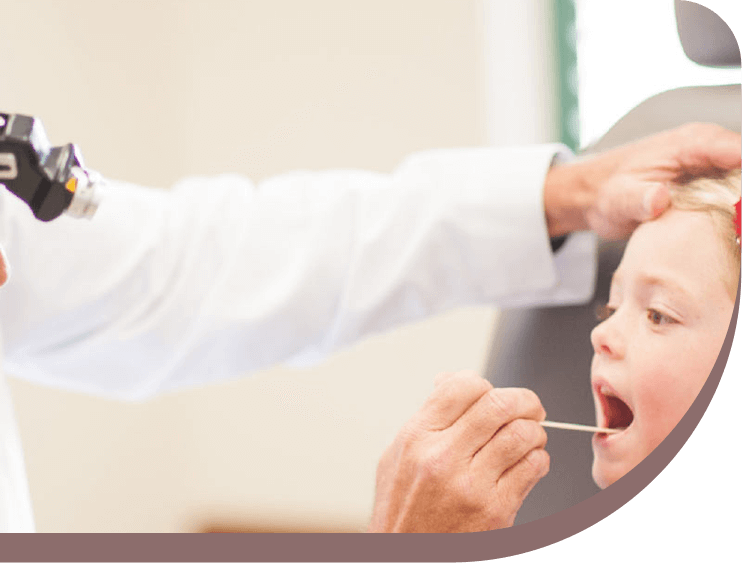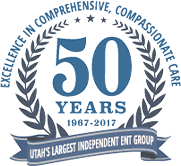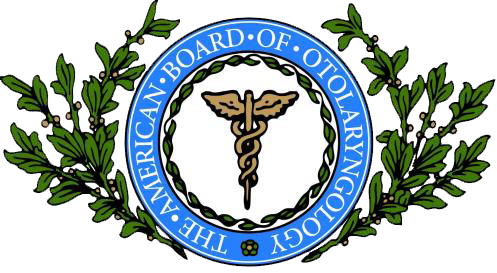
Snoring & Sleep Disorders
Snoring & Sleep Disorders – About
Forty-five percent of normal adults snore at least occasionally and 25 percent are habitual snorers. Problem snoring is more frequent in males and overweight people and usually worsens with age. Snoring occurs when your breathing is partially obstructed in some way while you’re sleeping. As you breathe, air travels through passages in your nose and throat. When these air passages are wide enough to allow air to flow freely, you breathe quietly. However, if the passages become too narrow, the tissues of the throat may start to vibrate, leading to snoring. An otolaryngologist (ENT Specialist) can help you to determine the cause, or causes, of your snoring and offer solutions. It is common for snorers to have multiple factors that contribute to their snoring problem, as opposed to just a single factor.
Problems in the structure of the nose may obstruct breathing. A crooked, or deviated, septum or swollen turbinates can lead to nasal obstruction. Nasal polyps, allergies, and chronic sinusitis can also cause nasal obstruction. These problems, in turn, can lead to mouth breathing and contribute to snoring. Large tonsils, a floppy soft palate or an elongated uvula are common findings with snorers because they can decrease movement of air through the mouth. A receding jaw or enlarged tongue may also obstruct oral breathing, by allowing the tongue to come into contact with the back of the throat. Weight gain increases the thickness of the tissues of the neck and throat, compromising the diameter of the airway.
In children, snoring may be a sign of problems with the tonsils and adenoids. A chronically snoring child should be examined by an otolaryngologist, who may recommend a tonsillectomy and adenoidectomy to return the child to full health.
Snoring & Sleep Disorders – Diagnosis
Light snoring may not disrupt your overall sleep quality. Heavy snoring may be associated with obstructive sleep apnea, which can be a serious sleep disorder.
Obstructive sleep apnea is a reduction in breathing or temporary stop of breathing during sleep due to blockage of the nose and/or throat. Besides snoring, gasp or snort in your sleep, Sleep apnea can decrease the level of oxygen in the blood and it can also disrupt sleep as your body attempts to restart breathing.
People with sleep apnea can feel tired even after a full night’s sleep, may have morning headaches, have problems with memory or concentration, and feel irritable. Sleep apnea also makes you more likely to develop certain other problems such as high blood pressure, diabetes, coronary artery disease, and stroke.
Snoring & Sleep Disorders – Treatment
Treatment depends on the diagnosis and level(s) of upper airway narrowing. In some cases, more than one area may be involved.
Snoring or Obstructive Sleep Apnea (OSA) may respond to various treatments offered by many otolaryngologist—head and neck surgeons.
Conservative treatments—In mild cases of obstructive sleep apnea, conservative therapy may be all that is needed. Overweight persons can benefit from losing weight. Losing weight can be difficult with untreated obstructive sleep apnea due to increased appetite and metabolism changes that can occur with obstructive sleep apnea. Individuals with obstructive sleep apnea should avoid the use of alcohol and certain sleeping pills, which make the airway more likely to collapse during sleep and prolong the apneic periods. People with sinus problems or nasal congestion should use nasal sprays or breathing strips to reduce snoring and improve airflow for more comfortable nighttime breathing.
Mechanical therapy—Positive Airway Pressure (PAP) therapy is the preferred initial treatment for most people with obstructive sleep apnea. With PAP therapy, patients wear a mask over their nose and/or mouth. An air blower gently forces air through the nose and/or mouth. The air pressure is adjusted so that it is just enough to prevent the upper airway tissues from collapsing during sleep. PAP therapy prevents airway closure while in use, but apnea episodes return when PAP is stopped or if it is used improperly. There are several styles, and types of positive airway pressure devices depending on specific needs of patients. For example CPAP (Continuous Positive Airway Pressure) is the most widely used of the PAP devices. The machine is set at one single pressure. Auto CPAP or Auto Bi-Level PAP uses a range of pressures that self-regulates during use depending on pressure requirements detected by the machine.
A custom-fit oral appliance, which repositions the lower jaw forward, may also be considered for certain patients with snoring/ OSA. This should be fitted by an otolaryngologist, dentist, or oral surgeon with expertise in sleep dentistry.
Surgery—Surgical procedures may help people with obstructive sleep apnea and others who snore but do not have sleep apnea. There are many types of surgical procedures, some of which are performed as outpatient procedures. Surgery is reserved for people who have excessive or malformed tissue obstructing airflow through the nose or throat, such as a deviated nasal septum, markedly enlarged tonsils, or small lower jaw with an overbite that causes the throat to be abnormally narrow. These procedures are typically performed after sleep apnea has failed to respond to conservative measures and a trial of CPAP. Types of surgery include:
- Uvulopalatopharyngoplasty (UPPP) is surgery for treating snoring and obstructive sleep apnea. It removes excess soft palate tissue and opens the airway. In addition, the remaining tissue stiffens as it heals, thereby minimizing tissue vibration. The size of the air passage may be further enlarged when a tonsillectomy is added to the procedure.
- Thermal ablation procedures reduce tissue bulk in the nasal turbinates, tongue base, and/or soft palate. These procedures are used for both snoring and OSA. Different methods of thermal ablation include bipolar cautery, laser, and radiofrequency. These procedures may be done in the operating room or during an office visit. Several treatments may be required.
- Methods to increase the stiffness of the soft palate without removing tissue include injecting an irritating substance that causes stiffness in the injected area near the uvula. Another method is inserting stiffening rods (Pillar implants) into the soft palate.
- Genioglossus and hyoid advancement is a surgical procedure for the treatment of sleep apnea. It prevents collapse of the lower throat and pulls the tongue muscles forward, thereby opening the obstructed airway.
- Tonsillectomy is a procedure that removes the tonsillar tissue in the back of the throat which is a common cause of obstruction in children with sleep apnea.
- Nasal surgery includes correction of nasal obstructions, such as a deviated septum
Conditions Treated
Follow us


Your Health Starts Here
"*" indicates required fields
